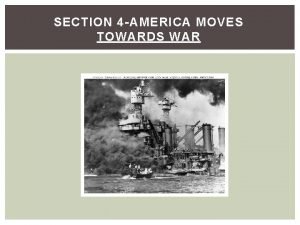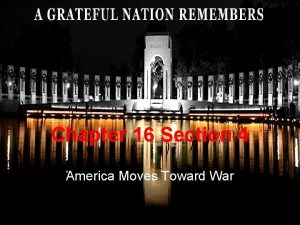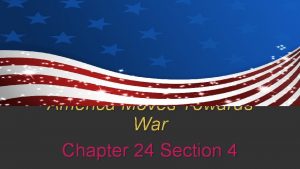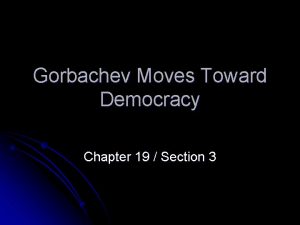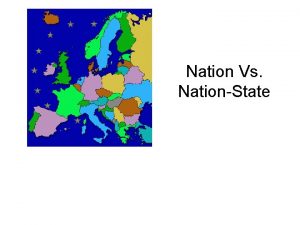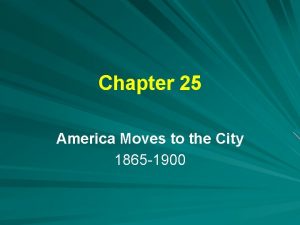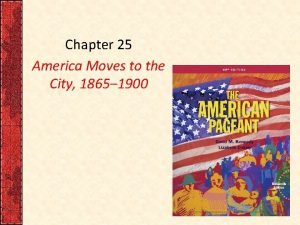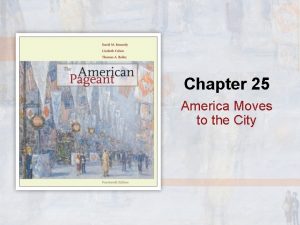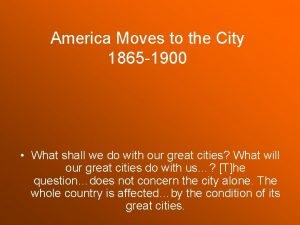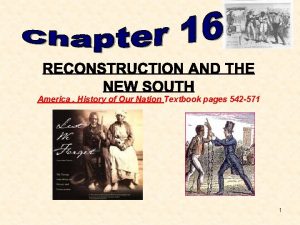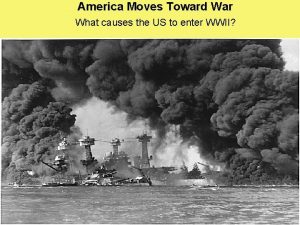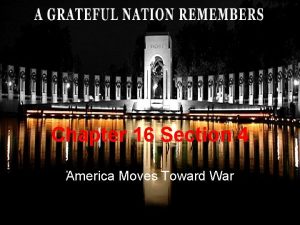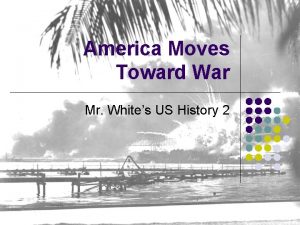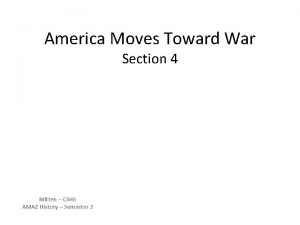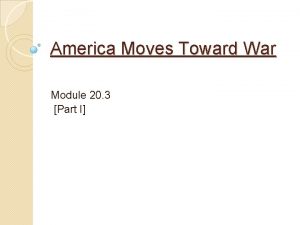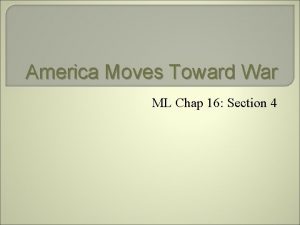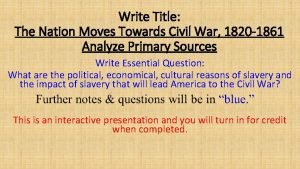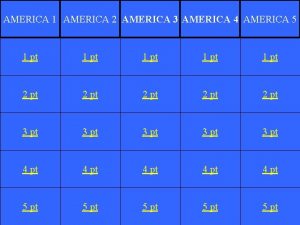America Moves toward War From a Nation of















- Slides: 15

America Moves toward War From a Nation of Neutrality to the Great Arsenal of Democracy

United States Musters Its Forces • In response to acts of aggression abroad, Congress passes the Neutrality Acts of 1937—no weapons can be sold to nations at war • 1939 Germany invades Poland; Britain and France declare war. IS America in danger? 1939 Roosevelt persuaded congress that American security depended on Britain • Congress passed the Neutrality Act of 1939 and the cash-and-carry policy went into effect

The Axis Threat • By summer of 1940, France had fallen and Britain was under siege • Roosevelt sent aid to the British rifles, machine guns, and Fighter Planes • On September 27, 1940 Germany, Italy and Japan had signed a mutual defense treaty Tripartite Act-designed to keep the United States out of the war • *Axis Powers Germany, Italy and Japan

Building Defenses • Roosevelt asked Congress to increase spending for National Defense • 1940 Congress passed the first peacetime military draft • 16 million men between the ages of 21 and 35 were registered

Great Arsenal of Democracy • Britain had spent all of their money • Lend-Lease Policy the president would lend or lease arms and other supplies to “any country whose defense was vital to the United States. ” • Congress passed the Lend Lease Act in March 1941. • U. S. not only helped Britain, but helped the Soviet Union as well

Great Arsenal of Democracy • This act was to aid Britain and the Soviet Union, and ensure the safe delivery of goods to the countries • Hitler deployed hundreds of U-boats to sink ships bringing supplies to Britain and the Soviet Union • In 1941, Roosevelt granted the Navy permission for U. S. warships to attack German U-Boats in self defense.

FDR’s Plans for War • Churchill and Roosevelt created a joint declaration of arms • Atlantic Charter a 1941 declaration of principles in which the United States and Great Britain set forth their goals in fighting the Axis Powers. Makes Britain and U. S. ALLIES • Allies The nations who fought against the Axis powers: United States, Britain, Soviet Union, (China, Mexico, Brazil, and numerous others)

Japan Attacks the United States • Germany’s European victories created new expansionist opportunities for Japanese Empire • In 1937, Hideki Tojo launched an invasion on China. French, Dutch and British colonies in the area were unprotected • British were too busy fighting off Hitler to protect their colonies. • Only the U. S. and its Pacific Islands were in Japan’s way.

Road to Pearl Harbor • In response to Japan’s attack on China in 1937, the United States begins supplying weapons to the Chinese • Since it is an “undeclared” war, the Neutrality Acts are not violated • The US continues to sell oil and scrap metal to the Japanese as well. • In 1941 the US cuts off oil to Japan to protest its aggression in French-Indo China

Japan Needs Oil! • The Japanese leadership decides to invade the Dutch East Indies to gain its Oil • This means that the US will most likely declare war on Japan since Holland Britain are allies. • If war against the US is inevitable then Japan will strike the first blow! • This is why Japan attacks Pearl Harbor on December 7 th 1941

Japan Attacks the United States • Tojo promised Emperor Hirohito that the Japanese government would attempt to preserve peace with the Americans. – November 5, 1941 Tojo ordered the Japanese Navy to prepare for an attack on the U. S. – U. S. had broken military codes and found out that Japan was going to attack but they did not know where or when. • Roosevelt sent a general warning out to all of the U. S. islands in the Pacific. • On December 7, 1941 the Japanese bombed the naval base at Pearl Harbor in Hawaii “The Day That Will Live in Infamy” – Killed 2, 403 Americans and wounded 1, 178. – The next day Roosevelt asked congress to declare war on Japan – American cultural bias against the Japanese made this attack so much more devastating • December 10, 1941 Germany and Italy declared war on the U. S.

The Pacific Theatre of World War II The United States Versus Japan

Japan’s Early Success • The first 6 months after Pearl Harbor, the Japanese conquered an empire • On the Asian mainland Japanese troops had overran Hong Kong, French Indo-China, Malaya, Burma, Thailand, and much of China. • In the Philippines, 80, 000 American and Filipino troops battled the Japanese for control. – General Douglas Mac. Arthur is ordered by Roosevelt to flee the island before being captured – “I’ll Be Back!”

The Battle of Midway • Turning point of the Pacific War – From this point the American Navy consistently drives the Japanese back towards Japan – Japan suffers the staggering loss of 4 aircraft carriers • American Strategy of “Island Hopping” • US Navy and Marine Corps travel from Island to Island slowly making their way to Japan • Each Island represents brutal combat against the Japanese army that is taught that surrender is dishonorable

The Atomic Bomb Ends the War • Several Battles convince the United States Leaders that Japan will not surrender: – Iwo Jima – Okinawa • President Truman is told about a secret weapon called the “Manhattan Project” • Truman authorizes the Military to use this weapon • August 6, 1945 the first ever atomic bomb is dropped on Hiroshima • August 9, 1945 the second atomic bomb is dropped on Nagasaki
 America moves toward war section 4
America moves toward war section 4 Chapter 16 section 4 america moves toward war
Chapter 16 section 4 america moves toward war Chapter 24 section 4 america moves toward war
Chapter 24 section 4 america moves toward war Toward civil war lesson 3 secession and war
Toward civil war lesson 3 secession and war Gorbachev moves toward democracy
Gorbachev moves toward democracy Nation state vs nation
Nation state vs nation Theories of origin of state
Theories of origin of state Nation state vs nation
Nation state vs nation Chapter 25 america moves to the city
Chapter 25 america moves to the city America moves to the city
America moves to the city Chapter 25 america moves to the city
Chapter 25 america moves to the city America moves to the city chapter 25
America moves to the city chapter 25 America moves to the city
America moves to the city America history of our nation textbook
America history of our nation textbook Chapter 29 section 1 marching toward war
Chapter 29 section 1 marching toward war Marching toward war
Marching toward war
